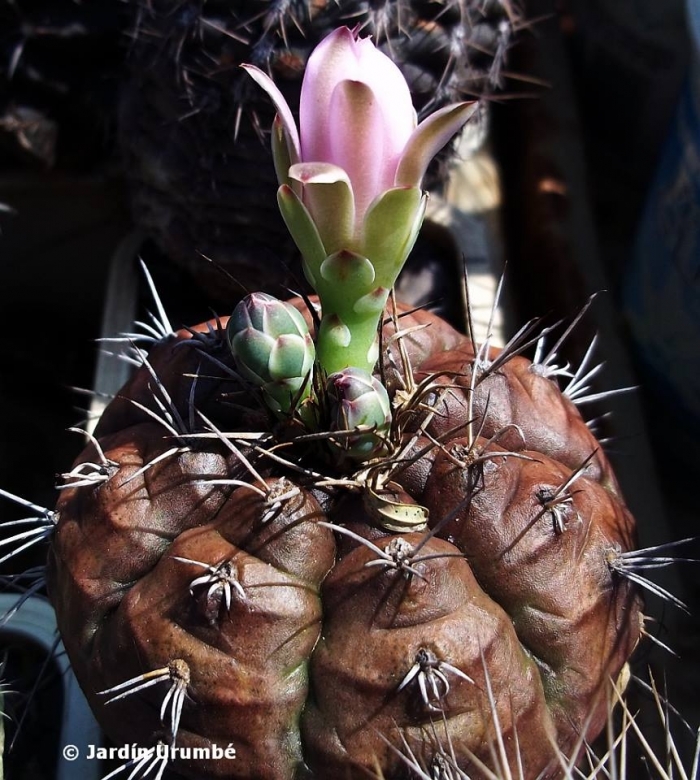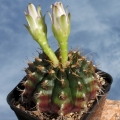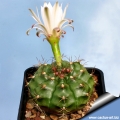Accepted Scientific Name: Gymnocalycium anisitsii (K.Schum.) Britton & Rose
Cactaceae (Britton & Rose) 3: 159, fig. 168. 1922 Britton & Rose

Gymnocalycium damsii var. rotundulum Photo by: Alexander Arzberger
In full sun the plant take a tan-red colouring. It flowers from spring to fall, and handle full sun to full shade, also the spines are nearly useless in terms of defense so a pretty 'user-friendly' plant.
Origin and Habitat: Bolivia ( and also Brazil & Paraguay) South America.
Habitat: G. damsii (anisitsii) grows in open areas under the protection of low bushes. It often form large groups and is extremely variable.
Synonyms:
See all synonyms of Gymnocalycium anisitsii
Description: Gymnocalycium damsiiSN|13315]]SN|13319]] var. rotundulum (Gymnocalycium anisitsiiSN|13319]]SN|13315]]) is a usually solitary colourful cactus common in cultivation, characterized by rounder and scarcely raised tubercles. However it is very similar (if not identical) to the standard G. damsii (G. anisistsii) and it is probably the exact same plant.
Stem: Up to 10 cm tall, 8-10 cm in diameter colourful and highly decorative, with characteristic horizontal clear and dark strips. The clear areas (above the areoles) are pastel-grey-pink while the dark zone (below the areoles) are deep olive-green to brown-purple.
Spines: Nearly useless in terms of defence.
Remarks: Seems to be a pretty variable plant you might get some other names which are effectively the same plant.... and also not sure all plants identified as this are really this.
Subspecies, varieties, forms and cultivars of plants belonging to the Gymnocalycium anisitsii group
Gymnocalycium anisitsii is a very polymorphic species with a large range of variability. Two subspecies are recognized, the nominate form and subsp. multiproliferum. There seems to be very little justification for vars. centrispinum, rotundulum, torulosum and tucavocense. Gymnocalycium griseopallidum from the salt-pan desert area on the Bolivia-Paraguay borders may well be another variety or local form which has become adapted to the peculiar local conditions of that region.
 Gymnocalycium anisitsii (K.Schum.) Britton & Rose: may be solitary or freely offsetting with white flowers. Spines 5 to 7, tortuous, up to 6 cm. long. It is a very polymorphic species with a large range of variability. Distribution: Bolivia, Paraguay.
Gymnocalycium anisitsii (K.Schum.) Britton & Rose: may be solitary or freely offsetting with white flowers. Spines 5 to 7, tortuous, up to 6 cm. long. It is a very polymorphic species with a large range of variability. Distribution: Bolivia, Paraguay. Gymnocalycium anisitsii subs. damsii (K.Schum.) G.J.Charles: has stems to 10 cm tall, 8-15 cm in diameter, green to brownish-green, often with horizontal strips. Ribs broad to acute, and more or less notched. Distribution: Bolivia, Paraguay and Brazil.
Gymnocalycium anisitsii subs. damsii (K.Schum.) G.J.Charles: has stems to 10 cm tall, 8-15 cm in diameter, green to brownish-green, often with horizontal strips. Ribs broad to acute, and more or less notched. Distribution: Bolivia, Paraguay and Brazil. Gymnocalycium anisitsii subs. damsii f. cristatum hort.: crested form. Various clones. Garden origin.
Gymnocalycium anisitsii subs. damsii f. cristatum hort.: crested form. Various clones. Garden origin. Gymnocalycium anisitsii subs. damsii f. monstruosum hort.: monstrous form. Various clones. Garden origin.
Gymnocalycium anisitsii subs. damsii f. monstruosum hort.: monstrous form. Various clones. Garden origin. Gymnocalycium anisitsii subs. damsii f. variegata hort.: variegated form. Various clones. Garden origin.
Gymnocalycium anisitsii subs. damsii f. variegata hort.: variegated form. Various clones. Garden origin. Gymnocalycium anisitsii var. griseopallidum H.Till & Amerh.: has paler greyish-green, sharply ribbed stem and greenish-white flowers. Distribution: Santa Cruz (Salinas de San Jose, Cordillera ) Bolivia.
Gymnocalycium anisitsii var. griseopallidum H.Till & Amerh.: has paler greyish-green, sharply ribbed stem and greenish-white flowers. Distribution: Santa Cruz (Salinas de San Jose, Cordillera ) Bolivia.- Gymnocalycium anisitsii subs. holdii Amerh.
 Gymnocalycium anisitsii subs. multiproliferum (P.J.Braun) P.J.Braun & Esteves: has numerous violet-green stems, longer spines, and rose-colored flowers. Distribution Mato Grosso do Sul, Brazil.
Gymnocalycium anisitsii subs. multiproliferum (P.J.Braun) P.J.Braun & Esteves: has numerous violet-green stems, longer spines, and rose-colored flowers. Distribution Mato Grosso do Sul, Brazil. Gymnocalycium anisitsii var. tucavocense Backeb. ex H.Till & Amerh.: has beautiful deep mauve to violet flowers, is remarkably prolific in branching and very precocious flowering.
Gymnocalycium anisitsii var. tucavocense Backeb. ex H.Till & Amerh.: has beautiful deep mauve to violet flowers, is remarkably prolific in branching and very precocious flowering. Gymnocalycium anisitsii var. tucavocense cv. Red Form: it is a garden selection characterized by an unusual bright red colouring of the body, this colour is due to a reduced production of chlorophyll pigments.
Gymnocalycium anisitsii var. tucavocense cv. Red Form: it is a garden selection characterized by an unusual bright red colouring of the body, this colour is due to a reduced production of chlorophyll pigments.- Gymnocalycium anisitsii subs. volkeri Amerh.
 Gymnocalycium damsii var. boosii Amerh.: has longer, thin, flexible usually twisted spines up to 6 cm long. Flowers bright pink or carmine-red. Distribution: S-E of Chocis, Santa Cruz, Bolivia.
Gymnocalycium damsii var. boosii Amerh.: has longer, thin, flexible usually twisted spines up to 6 cm long. Flowers bright pink or carmine-red. Distribution: S-E of Chocis, Santa Cruz, Bolivia. Gymnocalycium damsii var. centrispinum Backeb.: has 7 radial spines and one long needle-like central spine to 2 cm long. The flowers are white. Distribution: Bolivia, in the vicinity of Roboré.
Gymnocalycium damsii var. centrispinum Backeb.: has 7 radial spines and one long needle-like central spine to 2 cm long. The flowers are white. Distribution: Bolivia, in the vicinity of Roboré.- Gymnocalycium damsii subs. evae Halda, Horáček & Milt
 Gymnocalycium damsii var. rotundulum Backeb.: it is characterized by rounder and scarcely raised tubercles. Distribution: Bolivia, Brazil & Paraguay.
Gymnocalycium damsii var. rotundulum Backeb.: it is characterized by rounder and scarcely raised tubercles. Distribution: Bolivia, Brazil & Paraguay.- Gymnocalycium damsii var. torulosum Backeb.
 Gymnocalycium damsii cv. Purple Blush: has purple blushed stems and nice pink blooms. It seems related to Gymnocalycium damsii var. tucavocense to which it shares many characteristics.
Gymnocalycium damsii cv. Purple Blush: has purple blushed stems and nice pink blooms. It seems related to Gymnocalycium damsii var. tucavocense to which it shares many characteristics.
Bibliography: Major references and further lectures
1) Edward Anderson “The Cactus family” Timber Press, Incorporated, 2001
2) James Cullen, Sabina G. Knees, H. Suzanne Cubey "The European Garden Flora Flowering Plants: A Manual for the Identification of Plants Cultivated in Europe, Both Out-of-Doors and Under Glass" Cambridge University Press, 11/Aug/2011
3) David R Hunt; Nigel P Taylor; Graham Charles; International Cactaceae Systematics Group. "The New Cactus Lexicon" dh books, 2006
4) N. L. Britton, J. N. Rose “The Cactaceae. Descriptions and Illustrations of Plants of the Cactus Family.” Volume 4, The Carnegie Institution of Washington, Washington 1923
5) Curt Backeberg “Die Cactaceae: Handbuch der Kakteenkunde” Gustav Fischer Verlag, Stuttgart New York 1982–1985
6) E. W Putnam “GYMNOCALYCIUMS: A Guide for Growers” National Cactus & Succulent Society. Handbook No. 5. 1978
 Gymnocalycium damsii var. rotundulum Photo by: Valentino Vallicelli
Gymnocalycium damsii var. rotundulum Photo by: Valentino Vallicelli Gymnocalycium damsii var. rotundulum Photo by: Alexander Arzberger
Gymnocalycium damsii var. rotundulum Photo by: Alexander Arzberger Gymnocalycium damsii var. rotundulum Photo by: Cactus Art
Gymnocalycium damsii var. rotundulum Photo by: Cactus Art Gymnocalycium damsii var. rotundulum Photo by: Alexander Arzberger
Gymnocalycium damsii var. rotundulum Photo by: Alexander Arzberger Gymnocalycium damsii var. rotundulum Photo by: Cactus Art
Gymnocalycium damsii var. rotundulum Photo by: Cactus Art Gymnocalycium damsii var. rotundulum Photo by: Cactus Art
Gymnocalycium damsii var. rotundulum Photo by: Cactus Art Gymnocalycium damsii var. rotundulum Photo by: Valentino Vallicelli
Gymnocalycium damsii var. rotundulum Photo by: Valentino Vallicelli Gymnocalycium damsii var. rotundulum Photo by: Alexander Arzberger
Gymnocalycium damsii var. rotundulum Photo by: Alexander ArzbergerCultivation and Propagation: It is a summer grower species that offers no cultivation difficulties. Water regularly in summer (but do not overwater ) Keep this plant almost dry in winter at a minimum temperature of 0°C, prefer relatively rich substrate and low pH compost (if possible not limestone) otherwise growth will stop altogether. Feed with a high potassium fertilizer in summer. It is quite frost resistant if kept dry (hardy to -5° C)
Sun Exposure: Light shade. It may tolerate bright situations but is likely to suffer from sun scorch or stunted growth if over exposed to direct sunlight during the hottest part of the day in summer. This plant needs plenty of space for its roots, repotting should be done every other year or when the it has outgrown its pot. This species is particularly easy and accommodating, seldom suffer of cryptogamic diseases.
Propagation: Direct sow after last frost. (seldom produces offsets)
Your Photos

by Valentino Vallicelli

by Cactus Art




















